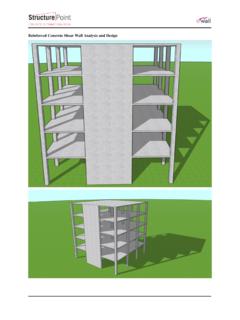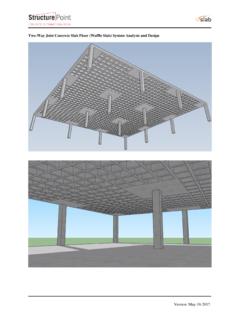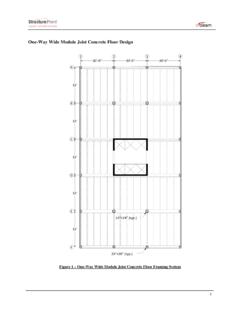Transcription of Reinforced Concrete Spread Footing (Isolated Footing ...
1 Reinforced Concrete Spread Footing ( isolated Footing ) analysis and design design Footing Reinforced Concrete Spread Footing ( isolated Footing ) analysis and design A square Spread Footing supports an 18 in. square column supporting a service dead load of 400 kips and a service live load of 270 kips. The column is built with 5000 psi Concrete and has eight #9 Grade 60 longitudinal bars. design a Spread Footing using 3000 psi normal weight Concrete and Grade 60 bars. It is quite common for the strength of the Concrete in the Footing to be lower than that in the column. Dowels may be required to carry some of the column load across the column- Footing interface. The top of the Footing will be covered with 6 in. of fill with a density of 120 lb/ft 3.
2 And a 6 in. basement floor. The basement floor loading is 100 psf. The allowable soil bearing pressure is 6000 psi. Using load resistance factors from ACI Code, the hand solution will be used for a comparison with the finite element analysis and design results of the engineering software program spMats. Figure 1 Reinforced Concrete Spread Footing Version: Sep-24-2018. Contents 1. Loads and Load Combinations ..4. 2. Foundation Shear Strength and Thickness ..4. Preliminary Foundation Sizing ..4. Two-Way Shear Strength ..4. One-Way Shear 3. Footing Flexural Strength and Reinforcement ..6. 4. Reinforcement Bar Development Length ..8. 5. Column- Footing Joint design ..9. Maximum Bearing Load - Top of Footing ..9. Allowable Bearing Load - Base of Column.
3 10. 6. Spread Footing analysis and design spMats Software .. 11. 7. design Results Comparison and Conclusions .. 16. Version: Sep-24-2018. Code Building Code Requirements for Structural Concrete (ACI 318-14) and Commentary (ACI 318R-14). Reference Reinforced Concrete Mechanics and design , 7th Edition, 2016, James Wight, Pearson, Example 15-2. spMats Engineering Software Program Manual , StucturePoint LLC., 2016. design Data For column fc' = 4,000 psi normal weight Concrete fy = 60,000 psi (8 #9 longitudinal reinforcement). For Footing fc' = 3,000 psi normal weight Concrete fy = 60,000 psi For loading: Dead load, D = 400 kips Live load, L = 270 kips Floor load, wfloor = 100 psf For fill: Depth = 6 in. Density = 120 lb/ft3. Allowable bearing pressure on the soil, qallowable = 6,000 psi 3.
4 1. Loads and Load Combinations The following load combinations are applicable for this example since dead and live load are only considered: The total factored axial load on the column: PD 400 560 . Pu Greater of Greater of Greater of 912 kips PD PL 400 270 912 . The strength reduction factors: For flexure: f = (function of the extreme-tension layer of bars strain) ACI 318-14 ( ). For shear: v = ACI 318-14 ( ). 2. Foundation Shear Strength and Thickness Preliminary Foundation Sizing Assume Footing thickness, h = 32 in. The net soil pressure is calculated as follows: qn qallowable weight Footing weight fill weightbasement floor weight floor load 32 6 6. qn 6000 150 120 150 100 5370 psf 12 12 12. Pservice 400 270. Ag , required 125 ft 2 ft ft qn 5370 /1000.
5 Try 11 ft 2 in. square by 32 in. thick. The factored net soil pressure is calculated as follows: Pu 912. qn,u 7310 psf Ag This value will be used for the following shear and flexural strength design calculations and to arrive at the minimum required Footing thickness. Two-Way Shear Strength The thickness of a Spread Footing is commonly governed by two-way shear strength. The average depth shall be the average of the effective depths in the two orthogonal directions. ACI 318-14 ( ). Assuming a bar size of #8, the average depth can be found as follows: 4. db db 1 1 . h cover 2 h cover db 2 32 3 32 3 1 . 2 2 . d avg 28 in. 2 2. 7310 46 . 2. Vu qn,u Tributary Area for Shear 805 kips 1000 12 . Vu 805. vu ksi 156 psi bo d 4 46 28.
6 Where bo is the perimeter of critical section for two-way shear in footings . The design shear strength for interior square column: .. 4 f c '.. 4 . vc Least of 2 f c' ACI 318-14 ( ).. s d ' . 2 b fc . o .. 4 1 3000 . 164 . 4 246 psi 164 psi v . vc Least of 2 1 3000 Least of u 1 332 . 40 28 . 2 1 3000 . 4 46 . Figure 2 Critical Section for Two-Way Shear 5. One-Way Shear Strength One-way shear check is performed even though it is seldom critical. 7310 30 . Vu qn,u Tributary Area for Shear 204 kips 1000 12 . Vc 2 fc' bw d ACI 318-14 ( ). Vc 2 3000 12 28 /1000 308 kips Vu < Vc Figure 3 Critical Section for One-Way Shear 3. Footing Flexural Strength and Reinforcement The factored moment at the critical section (at the face of the column) is calculated as follows: 7310 58 /12.
7 2. Mu . 954 kips-ft 1000 2 .. 6. Figure 4 Critical Section for Moment To determine the area of steel, assumptions have to be made whether the section is tension or compression controlled, and regarding the distance between the resultant compression and tension forces along the Footing section (jd). In this example, tension-controlled section will be assumed so the reduction factor is equal to , and jd will be taken equal to The assumptions will be verified once the area of steel in finalized. Assume jd d in. Mu 954 12000. As f y jd 60000 As f y 60000. Recalculate ' a ' for the actual As a in. f 'c b 3000 12 . a c in. 1 . t dt 28 c . Therefore, the assumption that section is tension-controlled is valid. Mu 954 12000. As f y (d a / 2) 60000 (28 / 2).
8 7. 60, 000 .. As ,min Greater of f b h ACI 318-14 ( ).. As ,min 12 32 < As As 3h 3 32 96 in.. smax lesser of lesser of 18 in. ACI 318-14 ( ). 18 in. 18 in.. Providing 11#8 bars with As = satisfies strength requirements. Since the Footing is square and davg is used for the flexural design in the x-direction. The same design (11#8) is used in the y-direction. 4. Reinforcement Bar Development Length Flexural reinforcement must be properly developed in a Concrete foundation in order for the foundation to perform as intended in accordance with the strength design method. The concept of the development length is stated as follows: minimum lengths of reinforcement must be provided beyond the locations of peak stress (critical sections).
9 In the reinforcement in order to fully develop the bars. Clear spacing between bars being developed = 18 in. 1 in. = 17 in. > 2db = 2 in. Clear cover = 3 in. > db = 1 in. Thus, Case 1 in Table from ACI 318-14 can be used as follows: . fy ld t e db for and larger bars 1. ACI 318-14 (Table ). 20 . f c' .. 1 60, 000 . ld in. 20 3, 000 .. Where: (Light weight modification factor: normal weight Concrete ) ACI 318-14 (Table ). t (Casting position modification factor: less than 12 in. of fresh Concrete placed below horizontal reinforcement) ACI 318-14 (Table ). e (Epoxy modification factor: uncoated or zinc-coated reinforcement) ACI 318-14 (Table ). The provided bar length is equal to: 12 18. ld , provided 3 55 in. ld in. 2 2. 8. 5.
10 Column- Footing Joint design Maximum Bearing Load - Top of Footing (a) f ' A A / A . Bn, Footing Lesser of . c 1 2 1. ACI 318-14 (Table ). ' . (b ) f c A1 2 . (a) 3, 000 182 12 . 2. /182 . Bn, Footing Lesser of . (b) 65 3, 000 182 2 .. (a) 4000 kips . Bn, Footing =Lesser of 1070 kips Pu 912 kips . (b) 1070 kips . Where: for bearing ACI 318-14 (Table ). A1 = Loaded area for consideration of bearing strength. A2 = Area of the lower base of a right pyramid or cone formed by extending lines out from the sides of the bearing area at a slope of 2 horizontal to 1 vertical to the point where the first such line intersects an edge. Figure 5 Definition of A1 and A2. 9. Allowable Bearing Load - Base of Column Bn,column fc' A1 ACI 318-14 (Table (c)).


